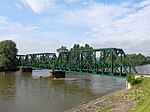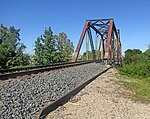Truss bridge
 Atrussbridge operated bySouthern Pacific RailroadinContra Costa County, Californiaconverted to pedestrian use and pipeline support | |
| Ancestor | Beam bridge[citation needed] |
|---|---|
| Related | None |
| Descendant | Cantilever bridge,truss arch bridge,transporter bridge,lattice bridge[citation needed] |
| Carries | Pedestrians,pipelines,automobiles,trucks,light rail,heavy rail |
| Span range | Short to medium – not very long unless it is continuous |
| Material | Timber,iron,steel,reinforced concrete,prestressed concrete |
| Movable | May be movable – seemovable bridge |
| Design effort | Medium |
| Falseworkrequired | Depends upon length, materials, and degree of prefabrication |
Atruss bridgeis abridgewhose load-bearingsuperstructureis composed of atruss,a structure of connected elements, usually forming triangular units. The connected elements, typically straight, may be stressed fromtension,compression,or sometimes both in response to dynamic loads. There are several types of truss bridges, including some with simple designs that were among the first bridges designed in the 19th and early 20th centuries. A truss bridge is economical to construct primarily because it uses materials efficiently.
Design
[edit]
The nature of atrussallows theanalysisof its structure using a few assumptions and the application ofNewton's laws of motionaccording to the branch ofphysicsknown asstatics.For purposes of analysis, trusses are assumed to be pin jointed where the straight components meet, meaning that taken alone, every joint on the structure is functionally considered to be a flexible joint as opposed to a rigid joint with the strength to maintain its shape, and the resulting shape and strength of the structure are only maintained by the interlocking of the components. This assumption means that members of the truss (chords, verticals, and diagonals) will act only in tension or compression. A more complex analysis is required where rigid joints impose significantbendingloads upon the elements, as in aVierendeel truss.
In the bridge illustrated in theinfoboxat the top, vertical members are in tension, lower horizontal members in tension,shear,and bending, outer diagonal and top members are in compression, while the inner diagonals are in tension. The central vertical member stabilizes the upper compression member, preventing it frombuckling.If the top member is sufficiently stiff then this vertical element may be eliminated. If the lower chord (a horizontal member of a truss) is sufficiently resistant to bending and shear, the outer vertical elements may be eliminated, but with additional strength added to other members in compensation. The ability to distribute the forces in various ways has led to a large variety of truss bridge types. Some types may be more advantageous when the wood is employed for compression elements while other types may be easier to erect in particular site conditions, or when the balance between labor, machinery, and material costs has certain favorable proportions.
The inclusion of the elements shown is largely an engineering decision based upon economics, being a balance between the costs of raw materials, off-site fabrication, component transportation, on-site erection, the availability of machinery, and the cost of labor. In other cases, the appearance of the structure may take on greater importance and so influence the design decisions beyond mere matters of economics. Modern materials such asprestressed concreteand fabrication methods, such as automatedwelding,and the changing price of steel relative to that of labor have significantly influenced the design of modern bridges.
Model bridges
[edit]A pure truss can be represented as a pin-jointed structure, one where the only forces on the truss members are tension or compression, not bending. This is used in the teaching of statics, by the building ofmodel bridges from spaghetti.Spaghetti is brittle and although it can carry a modest tension force, it breaks easily if bent. A model spaghetti bridge thus demonstrates the use of a truss structure to produce a usefully strong complete structure from individually weak elements.
United States
[edit]In theUnited States,because wood was in abundance, early truss bridges would typically use carefully fitted timbers for members taking compression and iron rods fortension members,usually constructed as acovered bridgeto protect the structure. In 1820, a simple form of truss,Town's lattice truss,was patented, and had the advantage of requiring neither high labor skills nor much metal. Few iron truss bridges were built in the United States before 1850.
Truss bridges became a common type of bridge built from the 1870s through the 1930s. Examples of these bridges still remain across the US, but their numbers are dropping rapidly as they are demolished and replaced with new structures. As metal slowly started to replace timber,wrought ironbridges in the US started being built on a large scale in the 1870s. Bowstring truss bridges were a common truss design during this time, with their arched top chords. Companies like theMassillon Bridge CompanyofMassillon, Ohio,and theKing Bridge CompanyofCleveland,became well-known, as they marketed their designs to cities and townships.
The bowstring truss design fell out of favor due to a lack of durability, and gave way to the Pratt truss design, which was stronger. Again, the bridge companies marketed their designs, with the Wrought Iron Bridge Company in the lead. As the 1880s and 1890s progressed,steelbegan to replace wrought iron as the preferred material. Other truss designs were used during this time, including the camel-back. By the 1910s, many states developed standard plan truss bridges, including steel Warrenponytruss bridges.
In the 1920s and 1930s,Pennsylvaniaand several states continued to build steel truss bridges, using massive steel through-truss bridges for long spans. Other states, such asMichigan,used standard plan concrete girder and beam bridges, and only a limited number of truss bridges were built.
Roadbed types
[edit]The truss may carry itsroadbedon top, in the middle, or at the bottom of the truss. Bridges with the roadbed at the top or the bottom are the most common as this allows both the top and bottom to be stiffened, forming abox truss.When the roadbed is atop the truss, it is a deck truss; an example of this was theI-35W Mississippi River bridge.When the truss members are both above and below the roadbed it is called a through truss; an example of this is thePulaski Skyway,and where the sides extend above the roadbed but are not connected, a pony truss orhalf-throughtruss.
Sometimes both the upper and lower chords support roadbeds, forming adouble-decked truss.This can be used to separate rail from road traffic or to separate the two directions of road traffic.
Since through truss bridges have supports located over the bridge deck, they are susceptible to being hit byoverheight loadswhen used on highways. TheI-5 Skagit River bridge collapsedafter such a strike; before the collapse, similar incidents had been common and had necessitated frequent repairs.[2]
Gallery
[edit]-
Prattthrough trussof the formerSeaboard Air Line Railway,located nearWillow, Florida;abandoned since the mid-1980s
-
Deck trussrailroad bridge over theErie CanalinLockport, New York
-
The four span through trussGeneral Hertzog Bridgeover theOrange RiveratAliwal Northcarries vehicular traffic
-
The through truss Skagit River bridge on Interstate 5collapsedafter an overhead support was hit by a passing truck
-
OldSan Jacinto Rivertruss bridge inHumble, Texas
-
Pony trussbridge of reinforced concrete
-
Sky Gate Bridge R atKansai International Airport,Osaka,Japan, is the longest double-decked truss bridge in the world. It carries three lanes of automobile traffic on top and two of rail below over nine truss spans.
-
Railroad Truss bridge over Trinity River nearGoodrich, Texas
-
TheHart Bridgespanning theSt. Johns RiverinJacksonville, Florida,is a continuous, cantilevered truss bridge which combines a suspended road deck on the 332-metre (1,088 ft) main span and through truss decks on the adjacent approach spans
-
Chevelon Creek Warren Pony Truss Bridge,Chevelon Creek, Navajo County Arizona built 1913
-
Railroad Truss Drawbridge across Buffalo Bayou—Houston
Multiple spans
[edit]Truss bridges consisting of more than onespanmay be either acontinuous trussor a series of simple trusses. In the simple truss design, each span is supported only at the ends and is fully independent of any adjacent spans. Each span must fully support the weight of any vehicles traveling over it (thelive load).
In contrast, a continuous truss functions as a single rigid structure over multiple supports. This means that the live load on one span is partially supported by the other spans, and consequently it is possible to use less material in the truss.[3]: 168 Continuous truss bridges were not very common before the mid-20th century because they arestatically indeterminate,which makes them difficult to design without theuse of computers.
A multi-span truss bridge may also be constructed usingcantileverspans, which are supported at only one end rather than both ends like other types of trusses. Unlike a continuous truss, a cantilever truss does not need to be connected rigidly, or indeed at all, at the center.[3]: 169–170 Many cantilever bridges, like theQuebec Bridgeshown below, have two cantilever spans supporting a simple truss in the center. The bridge would remain standing if the simple truss section were removed.
Truss types used in bridges
[edit]Bridges are the most widely known examples of truss use. There are many types,[4]some of them dating back hundreds of years. Below are some of the more common designs.
Allan truss
[edit]
TheAllan truss,designed byPercy Allan,is partly based on theHowe truss.The first Allan truss was completed on 13 August 1894 over Glennies Creek at Camberwell, New South Wales and the last Allan truss bridge was built over Mill Creek nearWisemans Ferryin 1929.[5][6]Completed in March 1895, theTharwa Bridgelocated atTharwa, Australian Capital Territory,was the second Allan truss bridge to be built, the oldest surviving bridge in theAustralian Capital Territoryand the oldest, longest continuously used Allan truss bridge.[7][8][9]Completed in November 1895, theHampden BridgeinWagga Wagga, New South Wales,Australia, the first of the Allan truss bridges with overhead bracing, was originally designed as a steel bridge but was constructed with timber to reduce cost.[10]In his design, Allan used Australianironbarkfor its strength.[11]A similar bridge also designed by Percy Allen is theVictoria Bridgeon Prince Street,Picton, New South Wales.Also constructed of ironbark, the bridge is still in use today for pedestrian and light traffic.[12]
Bailey truss
[edit]

TheBailey trusswas designed by the British in 1940–1941 for military uses during World War II. A short selection of prefabricated modular components could be easily and speedily combined on land in various configurations to adapt to the needs at the site and allow rapid deployment of completed trusses. In the image, note the use of pairs of doubled trusses to adapt to the span and load requirements. In other applications the trusses may be stacked vertically, and doubled as necessary.
Baltimore truss
[edit]
TheBaltimore trussis a subclass of the Pratt truss. A Baltimore truss has additional bracing in the lower section of the truss to prevent buckling in the compression members and to control deflection. It is mainly used for rail bridges, showing off a simple and very strong design. In the Pratt truss the intersection of the verticals and the lower horizontal tension members are used to anchor the supports for the short-span girders under the tracks (among other things). With the Baltimore truss, there are almost twice as many points for this to happen because the short verticals will also be used to anchor the supports. Thus the short-span girders can be made lighter because their span is shorter. A good example of the Baltimore truss is theAmtrak Old Saybrook – Old Lyme BridgeinConnecticut,United States.
Bollman truss
[edit]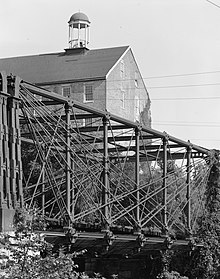
TheBollman Truss Railroad BridgeatSavage, Maryland,United States is the only surviving example of a revolutionary design in the history of American bridge engineering. The type was named after its inventor,Wendel Bollman,a self-educatedBaltimoreengineer. It was the first successful all-metal bridge design (patented in 1852) to be adopted and consistently used on a railroad. The design employswrought irontension members andcast ironcompression members. The use of multiple independent tension elements reduces the likelihood of catastrophic failure. The structure was also easy to assemble.
Wells Creek Bollman Bridgeis the only other bridge designed by Wendel Bollman still in existence, but it is a Warren truss configuration.
Bowstring truss
[edit]

Thebowstring trussbridge was patented in 1841[13]bySquire Whipple.[14]While similar in appearance to atied-arch bridge,a bowstring truss has diagonal load-bearing members: these diagonals result in a structure that more closely matches aParker trussorPratt trussthan atrue arch.
Brown truss
[edit]
In theBrown trussall vertical elements are under tension, with exception of the end posts. This type of truss is particularly suited for timber structures that use iron rods as tension members.
Brunel truss
[edit]SeeLenticular trussbelow.
Burr arch truss
[edit]
This combines an arch with a truss to form a structure both strong and rigid.
Cantilever truss
[edit]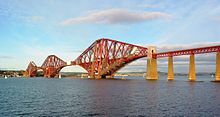
Most trusses have the lower chord under tension and the upper chord under compression. In acantilever trussthe situation is reversed, at least over a portion of the span. The typical cantilever truss bridge is a "balanced cantilever", which enables the construction to proceed outward from a central vertical spar in each direction. Usually these are built in pairs until the outer sections may be anchored to footings. A central gap, if present, can then be filled by lifting a conventional truss into place or by building it in place using a "traveling support". In another method of construction, one outboard half of each balanced truss is built upon temporary falsework. When the outboard halves are completed and anchored the inboard halves may then be constructed and the center section completed as described above.
Fink truss
[edit]
TheFink trusswas designed byAlbert Finkof Germany in 1854. This type of bridge was popular with theBaltimore and Ohio Railroad.TheAppomattox High Bridgeon theNorfolk and Western Railwayincluded 21 Fink deck truss spans from 1869 until their replacement in 1886.
There are alsoinverted Fink trussbridges such as theMoody Pedestrian Bridgein Austin, Texas.
Howe truss
[edit]
TheHowe truss,patented in 1840 byMassachusettsmillwrightWilliam Howe,includes vertical members and diagonals that slope up towards the center, the opposite of thePratt truss.[15] In contrast to the Pratt truss, the diagonal web members are in compression and the vertical web members are in tension. Few of these bridges remain standing. Examples includeJay BridgeinJay, New York;McConnell's Mill Covered BridgeinSlippery Rock Township, Lawrence County, Pennsylvania;Sandy Creek Covered BridgeinJefferson County, Missouri;andWestham Island BridgeinDelta, British Columbia,Canada.
-
A large timber Howe truss in a commercial building.
-
Jay Bridgeshowing the truss design.
-
Westham Island Bridgeshowing its wooden truss design.
K-truss
[edit]

TheK-trussis named after theKformed in each panel by the vertical member and two oblique members. Examples include the Südbrücke rail bridge over the River Rhine, Mainz, Germany,[16]the bridge on I-895 (Baltimore Harbor Tunnel Thruway) in Baltimore, Maryland, theLong–Allen BridgeinMorgan City, Louisiana(Morgan City Bridge) with three 600-foot-long spans, and the Wax Lake Outlet bridge inCalumet, Louisiana[17]
Kingpost truss
[edit]
One of the simplest truss styles to implement, theking postconsists of two angled supports leaning into a common vertical support.
Lattice truss (Town's lattice truss)
[edit]
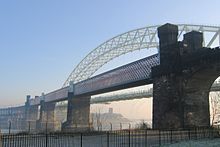
This type of bridge uses a substantial number of lightweight elements, easing the task of construction. Truss elements are usually of wood, iron, or steel.
Lenticular truss
[edit]


Alenticular trussbridge includes a lens-shape truss, with trusses between an upper chord functioning as an arch that curves up and then down to end points, and a lower chord (functioning as a suspension cable) that curves down and then up to meet at the same end points.[19]Where the arches extend above and below the roadbed, it is called alenticular pony truss bridge.ThePauli trussbridge is a specific variant of the lenticular truss, but the terms are not interchangeable.[19]
One type of lenticular truss consists of arcuate upper compression chords and lowereyebarchain tension links.Brunel'sRoyal Albert Bridgeover theRiver TamarbetweenDevonandCornwalluses a single tubular upper chord. As the horizontal tension and compression forces are balanced these horizontal forces are not transferred to the supporting pylons (as is the case with most arch types). This in turn enables the truss to be fabricated on the ground and then to be raised by jacking as supporting masonry pylons are constructed. This truss has been used in the construction of a stadium,[20]with the upper chords of parallel trusses supporting a roof that may be rolled back. TheSmithfield Street BridgeinPittsburgh, Pennsylvania,is another example of this type.

An example of a lenticular pony truss bridge that uses regular spans of iron is theTurn-of-River Bridgedesigned and manufactured by theBerlin Iron Bridge Co.
The Pauli truss is a variant of the lenticular truss, "with the top chord carefully shaped so that it has a constant force along the entire length of the truss."[19]It is named afterFriedrich Augustus von Pauli,whose 1857 railway bridge (theGroßhesseloher Brücke) spanned theIsarnearMunich.(See alsoGrosshesselohe Isartal station.) The term Pauli truss is not interchangeable with the term lenticular truss and, according to Thomas Boothby, the casual use of the term has clouded the literature.[19]
Long truss
[edit]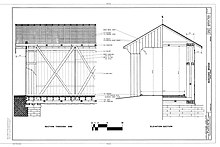
TheLong trusswas designed by Stephen H. Long in 1830. The design resembles aHowe truss,but is entirely made of wood instead of a combination of wood and metal.[21]The longest surviving example is theEldean Covered Bridgenorth ofTroy, Ohio,spanning 224 feet (68 m).[22]One of the earliest examples is theOld Blenheim Bridge,which with a span of 210 feet (64 m) and a total length of 232 feet (71 m) long was the second-longest covered bridge in the United States, until its destruction from flooding in 2011.
The Busching bridge, often erroneously used as an example of a Long truss, is an example of a Howe truss, as the verticals are metal rods.[23]
Parker (camelback) truss
[edit]

AParker trussbridge is a Pratt truss design with a polygonal upper chord. A "camelback" is a subset of the Parker type, where the upper chord consists of exactly five segments. An example of a Parker truss is theTraffic BridgeinSaskatoon,Canada. An example of a camelback truss is theWoolsey BridgenearWoolsey, Arkansas.
Partridge truss
[edit]
Designed and patented in 1872 byReuben Partridge,after local bridge designs proved ineffective against road traffic and heavy rains.[24]It became the standard forcovered bridgesbuilt in central Ohio in the late 1800s and early 1900s.
Pegram truss
[edit]
ThePegram trussis a hybrid between the Warren and Parker trusses where the upper chords are all of equal length and the lower chords are longer than the corresponding upper chord. Because of the difference in upper and lower chord length, each panel is not square. The members which would be vertical in a Parker truss vary from near vertical in the center of the span to diagonal near each end, similar to a Warren truss.George H. Pegram,while the chief engineer of Edge Moor Iron Company inWilmington, Delaware,patented this truss design in 1885.[25]
The Pegram truss consists of a Parker type design with the vertical posts leaning towards the center at an angle between 60 and 75°. The variable post angle and constant chord length allowed steel in existing bridges to be recycled into a new span using the Pegram truss design. This design also facilitated reassembly and permitted a bridge to be adjusted to fit different span lengths. There are twelve known remaining Pegram span bridges in the United States with seven inIdaho,two inKansas,and one each inCalifornia,Washington,andUtah.[citation needed]
Pennsylvania (Petit) truss
[edit]

ThePennsylvania (Petit) trussis a variation on thePratt truss.[citation needed]The Pratt truss includes braced diagonal members in all panels; the Pennsylvania truss adds to this design half-length struts or ties in the top, bottom, or both parts of the panels. It is named after thePennsylvania Railroad,which pioneered this design. It was once used for hundreds of bridges in the United States, but fell out of favor in the 1930s and very few examples of this design remain.[26]Examples of this truss type include theLower Trenton BridgeinTrenton, New Jersey,theFort Wayne Street BridgeinGoshen, Indiana,theSchell BridgeinNorthfield, Massachusetts,theInclined Plane BridgeinJohnstown, Pennsylvania,theEaston–Phillipsburg Toll BridgeinEaston, Pennsylvania,theConnecticut River BridgeinBrattleboro, Vermont,theMetropolis BridgeinMetropolis, Illinois,and theHealdsburg Memorial BridgeinHealdsburg, California.
Post truss
[edit]
APost trussis a hybrid between a Warren truss and a double-intersection Pratt truss. Invented in 1863 by Simeon S. Post, it is occasionally referred to as aPost patent trussalthough he never received a patent for it.[27]ThePonakin Bridgeand theBell Ford Bridgeare two examples of this truss.
Pratt truss
[edit]
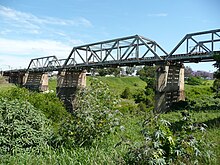

APratt trussincludes vertical members and diagonals that slope down towards the center, the opposite of theHowe truss.[15]The interior diagonals are under tension under balanced loading and vertical elements under compression. If pure tension elements (such aseyebars) are used in the diagonals, then crossing elements may be needed near the center to accept concentrated live loads as they traverse the span. It can be subdivided, creating Y- and K-shaped patterns. The Pratt truss was invented in 1844 byThomasand Caleb Pratt.[28][29]This truss is practical for use with spans up to 250 feet (76 m) and was a common configuration for railroad bridges as truss bridges moved from wood to metal. They arestatically determinatebridges, which lend themselves well to long spans. They were common in the United States between 1844 and the early 20th century.[29]
Examples of Pratt truss bridges are theGovernor's BridgeinMaryland;[29]theHayden RR BridgeinSpringfield, Oregon,built in 1882; theDearborn River High Bridgenear Augusta, Montana, built in 1897; and theFair Oaks BridgeinFair Oaks, California,built 1907–09.
TheScenic BridgenearTarkio, Montana,is an example of a Pratt deck truss bridge, where the roadway is on top of the truss.
Queenpost truss
[edit]
Thequeenpost truss,sometimes called "queen post" or queenspost, is similar to a king post truss in that the outer supports are angled towards the center of the structure. The primary difference is the horizontal extension at the center which relies onbeamaction to provide mechanical stability. This truss style is only suitable for relatively short spans.[30]
Smith truss
[edit]
TheSmith truss,patented by Robert W Smith on July 16, 1867,[31]has mostly diagonal criss-crossed supports. Smith's company used many variations of this pattern in the wooden covered bridges it built.
While most all of the bridges built in the 19th century in theJackson County, Ohio,area used the Smith truss design, theJohnson Road Covered Bridgeis the last known surviving example in the state.[32]
Thacher truss
[edit]
TheThacher truss[33]combines some of the characteristics of aPratt trusswith diagonals under tension and of aHowe trusswith diagonals under compression, which is rare.
Truss arch
[edit]
Atruss archmay contain all horizontal forces within the arch itself, or alternatively may be either a thrust arch consisting of a truss, or of two arcuate sections pinned at the apex. The latter form is common when the bridge is constructed ascantileversegments from each side as in theNavajo Bridge.
Vierendeel truss
[edit]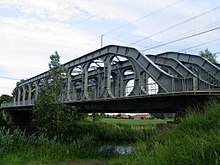
TheVierendeel truss,unlike common pin-jointed trusses, imposes significant bending forces upon its members—but this in turn allows the elimination of many diagonal elements. It is a structure where the members are not triangulated but form rectangular openings, and is a frame with fixed joints that are capable of transferring and resisting bending moments. While rare as a bridge type due to higher costs compared to a triangulated truss, it is commonly employed in modern building construction as it allows the resolution of gross shear forces against the frame elements while retaining rectangular openings between columns. This is advantageous both in allowing flexibility in the use of the building space and freedom in selection of the building's outercurtain wall,which affects both interior and exterior styling aspects.
Waddell truss
[edit]
Patented 1894 (U.S. patent 529,220); its simplicity eases erection at the site. It was intended to be used as a railroad bridge.
One example was theWaddell "A" Truss BridgeinParkville, Missouri.
Warren truss
[edit]
TheWarren trusswas patented in 1848 byJames Warrenand Willoughby Theobald Monzani, and consists of longitudinal members joined only by angled cross-members, forming alternately invertedequilateral triangle-shaped spaces along its length, ensuring that no individualstrut,beam, ortieis subject to bending or torsional straining forces, but only to tension or compression. Loads on the diagonals alternate between compression and tension approaching the center, with no vertical elements, while elements near the center must support both tension and compression in response to live loads. This configuration combines strength with economy of materials and can therefore be relatively light. The girders being of equal length, it is ideal for use in prefabricated modular bridges. It is an improvement over the Neville truss which uses a spacing configuration ofisosceles triangles.
Whipple truss
[edit]


AWhipple truss,named after its inventorSquire Whipple,is usually considered a subclass of the Pratt truss because the diagonal members are designed to work in tension. The main characteristic of a Whipple truss is that the tension members are elongated, usually thin, and at a shallow angle, and cross two or more bays (rectangular sections defined by the vertical members).
Wichert truss
[edit]
TheWichert trussis a modified type ofcontinuous trusswhich isstatically determinateand helps avoid some of the other shortcomings of continuous trusses.[34]It was patented in 1930 byPittsburgh-based civil engineer Edward Martin Wichert (1883–1955).[35][36]
The defining feature of this truss type is a hingedkite-shapedsection above each intermediate support.[citation needed]Only about ten Wichert truss bridges were ever built, mostly in Pennsylvania and Maryland. Of these, one of the best known is theHomestead Grays Bridgein Pittsburgh.[37]
Truss bridge video
[edit]Driving across a truss bridge: The video shows the roadway perspective of a through truss bridge over theWillamette RiverinHarrisburg, Oregon.The bridge features three simply supported Parker Truss spans.
References
[edit]- Historic American Engineering Record(1976)."Trusses: A Study by the Historic American Engineering Record"(PDF).National Park Service.Retrieved2015-05-29.
Footnotes
[edit]- ^Science and IndustryArchived2017-02-15 at theWayback Machine,Members of a Truss Bridge by Benj. F. La Rue, Home Study Magazine, Published by the Colliery Engineer Company, Vol 3, No. 2, March 1898, pages 67-68.
- ^"Temporary Skagit River bridge may be open in weeks".King 5 television.May 26, 2013. Archived fromthe originalon June 7, 2013.RetrievedMarch 27,2013.
- ^abAdams, Charles Kendall, ed. (1909). "Bridges".Universal Cyclopædia and Atlas.New York: D. Appleton and Company. pp. 161–174.RetrievedSeptember 1,2022.
- ^Kirsanov, M. (2019).Planar Trusses: Schemes and Formulas.GB: Cambridge Scholars Publishing. p. 206.ISBN978-1-5275-3531-2.
- ^"Timber Truss Bridges"(PDF).McMillan Britton & Kell Pty Limited.Roads and Traffic Authority. December 1998.Archived(PDF)from the original on 19 March 2011.Retrieved23 November2010.
- ^"Tharwa Bridge Conservation Management Plan"(PDF).Philip Leeson Architects.Roads ACT. 5 March 2009. pp. 42, 45.Archived(PDF)from the original on 21 February 2011.Retrieved23 November2010.
- ^"1307.8 – Australian Capital Territory in Focus, 2007".Australian Bureau of Statistics.27 November 2007.Archivedfrom the original on 14 October 2012.Retrieved23 November2010.
- ^"Tharwa Bridge".Engineers Australia.Canberra's Engineering Heritage. Archived fromthe originalon 2011-02-19.Retrieved23 November2010.
- ^"July 2010 Newsletter | Engineers Australia".engineersaustralia.org.au.Archivedfrom the original on 2021-10-01.Retrieved2021-03-24.
- ^"Minutes of State Heritage Register Committee meeting"(PDF).State Heritage Register Committee.Heritage Council of New South Wales. 5 November 2008. p. 5. Archived fromthe original(PDF)on 17 March 2011.Retrieved23 November2010.
- ^"Hampden Bridge, Wagga Wagga, NSW".Timber Building in Australia. Archived fromthe originalon 2013-05-12.Retrieved2008-06-05.
- ^Google-maps "-34.180255,150.610654" clearly shows bridge with traffic
- ^U.S. patent 2,064
- ^Gardner, Denis P. (2008).Wood, Concrete, Stone, Steel: Minnesota's Historic Bridges.Minneapolis: University of Minnesota Press. p. 51.ISBN978-0-8166-4666-1.
- ^abMatsuo Bridge Company,Bridge Types – TrussArchived2006-09-05 at theWayback Machine,accessed September 2007
- ^Panoramio- Reviewed 2020-03-23
- ^Historic Context for Louisiana BridgesArchived2020-12-24 at theWayback Machine- Retrieved 2020-03-23 (section 3, pp 71)
- ^"Aiken Street Bridge: Ouellette Bridge".HistoricBridges.org.2018.Archivedfrom the original on 9 July 2018.Retrieved9 July2018.
- ^abcdBoothby, Thomas (2020)."Designing American Lenticular Truss Bridges 1878–1900".History Cooperative.Archivedfrom the original on 5 November 2020.Retrieved5 March2020.
- ^"Arizona Cardinals Stadium".Archived fromthe originalon 2007-11-03.Retrieved2008-04-28.
- ^"CoveredBridgeSite, Long truss".Archivedfrom the original on 2018-05-02.Retrieved2008-10-20.
- ^Eldean Covered Bridge – Troy, Ohio – Covered Bridges onArchived2012-10-18 at theWayback Machine.Waymarking. Retrieved on 2013-07-23.
- ^"Busching Bridge".CLR Inc. Construction and Transportation. Archived fromthe originalon August 20, 2011.RetrievedJune 25,2012.
- ^Kennedy, Willella Shearer. "Heritage: Being Little Stories of Union County".Union County Historical Society,Printed by The Marysville Journal Tribune. 1963. Pg. 48.
- ^US 314262,Pegram, George H., "Truss for Roofs and Bridges", published 10-24-1881, issued 03-24-1885
- ^National Register of Historic Places Registration FormArchived2013-01-15 at theWayback MachineforHealdsburg Memorial Bridge,California State Park System, accessed 2011-12-26.
- ^Jackson, Donald C. (1995).Great American Bridges and Dams.New York: John Wiley & Sons. p.92.ISBN978-0-471-14385-7.
- ^Thomas and Caleb Pratt,US patent 3523in European Patent Office database
- ^abcMaryland Historical Trust Property Number PG-74B-1 & AA-85I(PDF),Maryland Inventory of Historic Bridges,archived(PDF)from the original on 26 December 2013,retrieved5 January2013
- ^Covered Bridge's Truss TypesArchived2006-09-04 at theWayback Machine
- ^"R.W. Smith Truss Patent 66,900".United States Patent Office.United States of America. July 16, 1867.Archivedfrom the original on 11 November 2018.Retrieved10 November2018.
- ^Lorrie K. Owen, ed. (1999).Ohio Historic Places Dictionary, Volume 2.Somerset Publishers, Inc. p. 794.ISBN9781878592705.Archivedfrom the original on 2020-06-14.Retrieved2020-01-05.
- ^"Thacher Truss Bridge, Spanning Linville Creek, Broadway, Rockingham County, VA".Library of Congress.Archivedfrom the original on 2020-12-13.Retrieved2021-02-04.
- ^Steinman, D. B. (1932).The Wichert Truss.New York: D. Van Nostrand Company, Inc.RetrievedAugust 29,2022.
- ^"The Wichert Truss".Historic Highway Bridges in Maryland: 1631-1960, Historic Context Report(PDF).Maryland Department of Transportation State Highway Administration. 1995.RetrievedAugust 27,2022.
- ^"E. M. Wichert Services Set For Tomorrow".Pittsburgh Post-Gazette.March 23, 1955.RetrievedAugust 29,2022– via Newspapers.
- ^Wilson, Helen; Wilson, Todd (November 2017)."From Browns to Grays: Evolution of the Homestead Grays Bridge"(PDF).Historic Bridge Bulletin.4(3): 5–9.RetrievedAugust 27,2022.
External links
[edit]- Historic Bridges of Michigan and Elsewhere– Many photos of truss bridges are available on this informative and mainly truss-focused bridge website.
- Historic Bridges of Iowa– An illustrated list of different architectural bridge types found in Iowa, US. Many of these are truss bridges.
- Historic Bridges of the U.S.– An enormous database of historic bridges. Over 17,400 truss bridges are listed here.
- Iron and Early Steel Bridges of OhioA comprehensive inventory of all remaining truss bridges in Ohio. Includes maps, photos, and invites visitor assistance in identifying extant or demolished bridges.
- Matsuo Bridge Company: Bridge Types – Truss
- Management Plan for Historic Bridges in Virginia: The 2017 Update—Virginia Department of Transportation's plan for managing its historic bridges, including metal truss bridges. The update includes sections on study findings such as "General Issues Regarding Metal and Metal Truss Bridges (Including Potential Life Span)," "Coatings Issues for Metal Truss Bridges: Painting, Metallizing, and Galvanizing," and "Truss Bridge Capacity and Overloading Potential."
- structurae.deTheStructuraedatabase on bridges.











